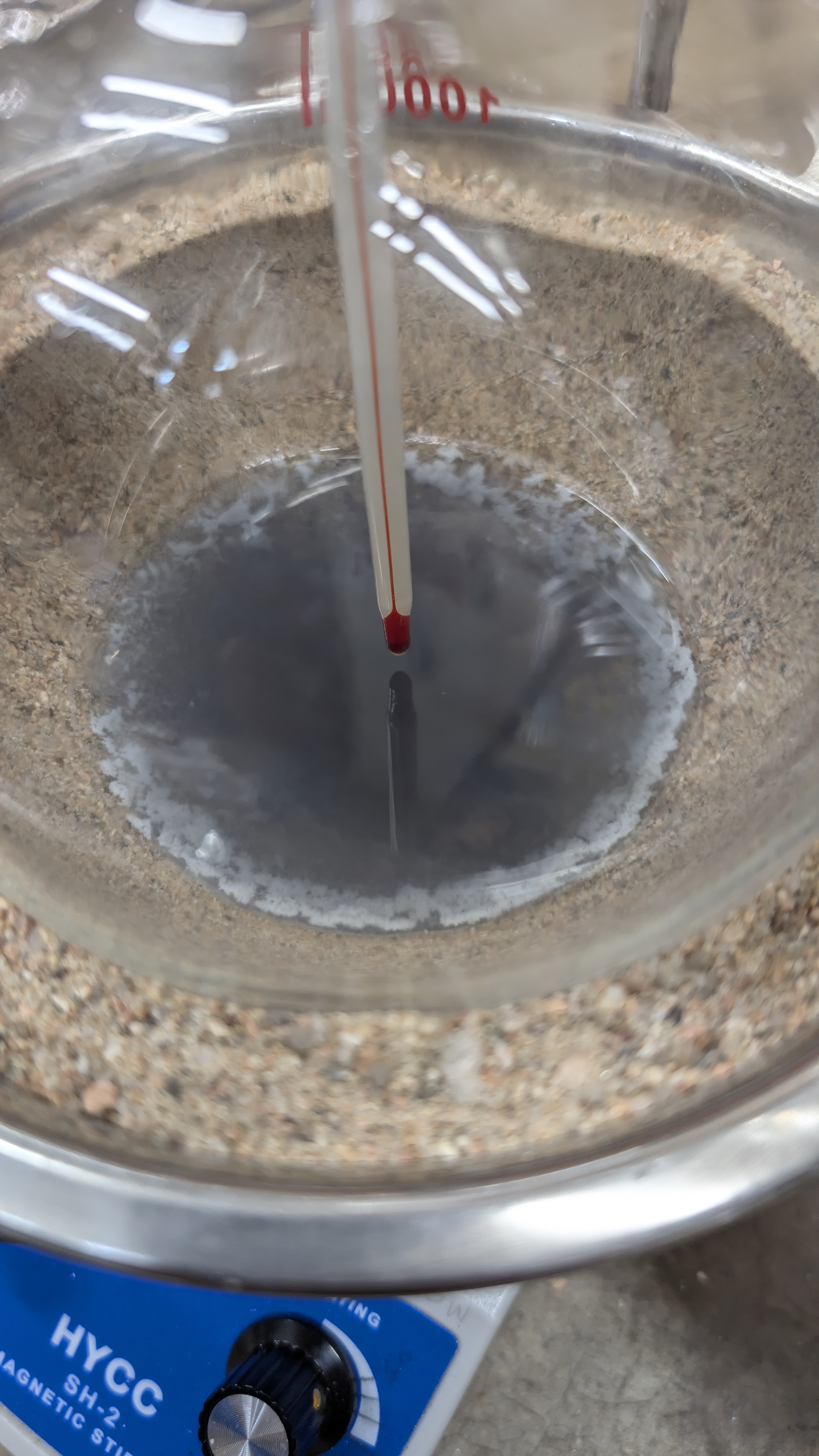Edit: Deleting this post. It’s starting to get controversial, but that’s OK. Not what I planned on, but whatevers.
No no no no no.
I’m a chemist. Organic chemistry PhD, now a process chemist in the industry. I do this for a living. Do not distill isopropanol that’s been exposed to air for any meaningful length of time.
Isopropanol slowly reacts with oxygen in the air to generate peroxides that, when you concentrate them down, EXPLODE. Source. Sorry, not an open access journal. But please take my word for it.
Unless you have a way of confirming the peroxide levels in your isopropanol are near zero, do not concentrate it down by distillation. You’ll blow up your glassware, which will probably expose what you’re distilling to your heat source, which will generate a secondary fireball.
PLEASE do not do this.
deleted by creator
The issue with isopropanol peroxide formation is that exposing it to air – even when just using it, like when you’re cleaning parts – starts the process. The air in the head space of your containers is also enough to form them over time. You don’t necessarily need to see solids in the containers for it to be dangerous, since they’ll crystallize out as you concentrate the solution during distillation.
It’s also a numbers game. It probably won’t explode the first time you do it. But there’s a chance each time. Do it enough, and you’ll have an incident.
There are chemical reductants that can clear peroxides. For industrial scale isopropanol distillation, I’m not sure what they use. It may be that they just never distill down to the point that peroxides concentrate to a dangerous level.
deleted by creator
Concentrated Hydrogen peroxide is scary AF!
I love EnF. But I assure you, organic peroxide formers are scarier.
This is the exact video I thought of and where I learned about them!
Sounds like fun! Got to go get a still though.
Please, don’t do this thing.
deleted by creator
This is legit cool, but the fact that you’re doing this on a garage floor instead of in a hood or outside is terrifying
deleted by creator
These companies barely release data sheets for pla filaments. I wouldn’t boil anything with resin in it in any garage for any amount of money.
https://www.elegoo.com/blogs/3d-printing/elegoo-resin-sds
Isopropylidenediphenol, aka bpa
Edit, I just keep finding more shit in the sds, trimethylcyclohexyl acrylate, butyl acrylate, repeated exposure can lead to lung damage
Brother, I hope you’re in one of those Andromeda Strain full body suits.
(For other readers, I am not arguing the safety points with any of this stuff. There is risk with everything about this process. Period. Understanding the properties of other chemicals is super important my comments are an addendum, not an argument.)
Not too worried about the BPA as the IPA boiling point is way too low. (At my altitude, the temperature is holding at ~84C.)
The acrylates are a bit nastier, but something to think more about. I’ll need to dig into why the resin is clumping at temperature, as that is probably the acrylates doing something special.
Still, this is extremely diluted solution until the last bits and don’t evaporate all the IPA so the resin doesn’t get cooked. (Working in a reasonable temperature range does mitigate some of the nastiness.)
TLDR for anyone reading: Do not do this!
There is a very well laid out reason by @becausechemistry@lemm.ee in this thread, but suffice to say this is dangerous to an extreme and is not worth the risk to save a little money.
How much $ you saving (or any other motivations)?
Don’t have frames of reference so perhaps what proportion less are you paying by doing this?
Assuming it’s no small sum/% given risks called out by you and a couple others. Glad you got a discussion going so you can give it all more thought!
The cost savings is quite good, actually. 1 liter of 99.9% IPA is between $10-15, and I have cleaned about 5 liters in this run. Power is not as bad as a thought for a 350W hot plate, so at maximum, it probably only costs $1 for about a 5 hour run, and that is overestimated.
The extra glass purchased was probably about ~$300 but I have a nice selection of distillation and reflux tubes now. (My full collection of glass is probaby about $800) The heated stir plate was about $40, but I have a proper heating mantle arriving today which was $200.
I use 5 liters at a time for my resin print washing and I am guessing there is about a 250ml-500ml loss due to evaporation or spillage. There is about a 200ml loss due to waste product after distillation since I want an easy cleanup. With other random losses, let’s round down to 4 liters of clean IPA after is all is said and done.
So if I give myself a realistic buffer for random costs, I save about $30 per 5 liter run. $20 after topping off my supply with a new bottle of IPA.
My motivation was is due to the waste, not the cost. Trashing that much IPA just doesn’t appeal to me and I use a lot more of it than most hobbyists. From 3D printing to bulk drying things and even general purpose cleaning, I can easily generate a few liters of waste IPA at a time.
Even with the risks involved, it’s within my personal tolerance if only at the cusp of that, TBH. Working with other nasty things like fuming nitric acid or mercury is something I won’t touch. (I have been tempted to work with high temperature mercury before, but I that is insane, even by my standards.)
Do you take any steps to clean the wash before boiling it? Filtering or anything like that?
I’ve had some success using aluminum sulfate to precipitate resin out of the wash based on this guy’s work: Recycle Isopropyl Alcohol FAST! | Recovering IPA From 3D Printer Resin Wash
I haven’t tried distillation… as you say, it’s risky.
What does your waste look like after distillation? And… what would you think about using an alcohol still for this, instead of lab glassware?
I have been thinking about aluminum sulfate and/or vacuum filtration for a while as those would be safer. However, I wouldn’t have been able to expand on my glass collection, so there is that.
The waste is fairly dark from the dyes and will mostly solidify once all the IPA and other solvents evaporate away. There be some nasty stuff in there that I can keep contained and away from everything while it cures and it’s a much easier quantity to dispose of.
I wouldn’t use a closed alcohol or water still for this as I can’t control or monitor anything. There are a few videos of people who use alcohol/water stills for this reason, but that is a bit janky, even for me. The biggest thing involved is temperature control, IMHO. I don’t want any bit of this stuff to exceed 85C and I know my apparatus is sealed properly. Having a water cooled glass distillation tube I can see is super important as well. It gives me a good visual about what is being extracted and when. (I am assuming you ment one of those electric alcohol stills you can get on Amazon.)
In my case, I am using an alcohol still in its purest form.
Edit: Here is some of the waste from today. The white stuff is solidified resin and you can see the concentrate. There seems to be about 100-150ml of IPA left.

Yo, this thread caught my eye, but because it’s deleted, it’s unclear exactly what it’s about. Can someone summarize exactly what I’m to avoid?
Don’t distill your own isopropanol in your garage/yard. Simple as that.
That is shocking because many articles on the internet suggest this, and I myself have been distilling IPA for years.
Not trying to challenge or argue, but I’m just surprised and a little embarrassed.
Can anyone comment why this hasn’t been a problem for me? Is this a matter of potency? Or number of cycles of distilling?
This post goes into detail why you shouldn’t do it: https://lemmy.ml/post/19598195
As to why there are so many articles on the internet: if there are many articles recommending jumping off a cliff… /j
That stuff is dangerous. Don’t trust anyone on that stuff, just because they have a homepage.
I’m guessing you were just lucky.
Have you tried using typical water filters and letting the alcohol filter through? I suppose it wouldn’t remain as pure as distilling, but might be mostly reusable while posing no immediate fire hazard.
deleted by creator
What I do is just expose the dirty isopropanol to sun or UV in general - the resin will precipitate. Then just filter it out and you have clean isopropanol.
deleted by creator
I see, to be honest I have not checked how clean it actually is. It is visually transparent, as opposed to the used one, but you are probably correct.
It may be worthwhile checking this out as an alternative: https://hackaday.com/2022/10/12/toilet-paper-tube-pulls-dissolved-resin-from-ipa-cures-it-for-disposal/
You deleted your comments but not the post 🤪
A BIT?!!! oh fuck no
You would be amazed at how many extremely dangerous processes, chemicals and activities we are exposed to on a daily basis, without even realizing it.
This just exceeds the risk tolerance of what some people would want to openly see. My “oh fuck no” moment would be watching rock climbers using tiny bits of metal to prevent them from falling to their death from 200 feet. (Then there are those free climbers… Eesh.)
My point is that there are ways to reduce risk and it’s usually very basic. However, risk is always present and we can never forget that.






